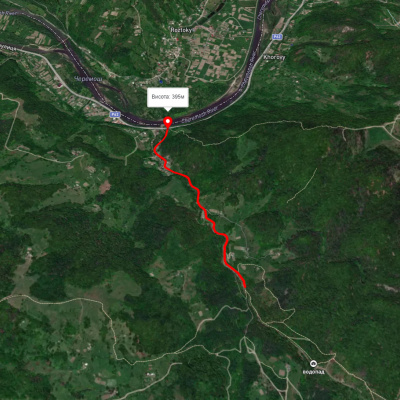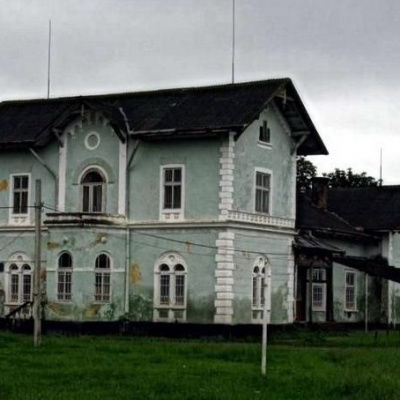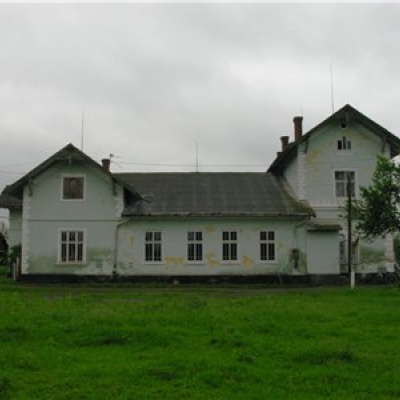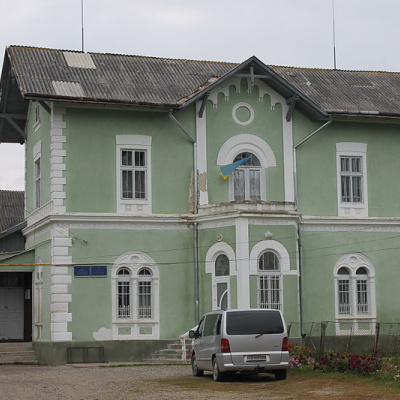Shimonovych Palace, Dubivtsi
On the road from Chernivtsi to Ivano-Frankivsk, near the turn to Vyzhnytsia, there is a village called Dubivtsi, which can serve as a great stop for you along with a cultural program - a visit to the palace of the Barons Shymonovych in Dubivtsi.
The palace was built on the eve of the First World War in 1914 by a local baron Shimonovych, who spent most of his time in Chernivtsi. He laid out the palace together with the park around it, of which, unfortunately, only one tree remains. The palace served as his residence for several years, although he left a warm impression in the memory of the villagers - according to legend, he was a decent and honest man. The building and construction of the palace was a real curiosity in the village at that time - there was even an elevator from the kitchen that served food.
Next to the palace, there is a chapel that was built as a family tomb for the baron's family. The baron's parents and son, who died in childhood from a sore throat, are indeed buried there. His daughter studied at a local school. When the war came to Bukovyna in 1941, the Shymonovych family finally left their estate and emigrated. Since then, no one in the village has heard of them.
The subsequent history of the palace resembles the classic fate of similar buildings throughout the Soviet Union: it managed to become a fertilizer warehouse, a club, a nursery, and a library. Today it houses the village council and a bar.
From the outside, the building stands out among the village buildings. The light green building in a rather original style immediately catches the eye. The surrounding park has not been preserved, but a small pond has been left behind. The interiors have not been preserved either. They still try to keep the building in good condition, anda park has been set up on the territory near the palace.
There are three palaces in the Kitsman district that are architectural monuments inherited from their ancestors. These are the estate of Otto and Lisa Goldner (the village of Khlivyshche, now a local school), the Manesku Palace (the village of Chortorya, now the Chortorya Psychoneurological Boarding School), and the Shymonovych Palace in Dubivtsi, which houses the village council, club, and library. This Art Nouveau house, built in 1914 by Baron Shymonovych (another variant of the surname, called Shymonovskyi in Dubivtsi), served as his family estate for several years, with a garden around it. The ancestors of the baron, who left Bukovyna in 1941, are buried in a small chapel across the road, which was built in the eighteenth century. In Soviet times, the building began to deteriorate, and there was not enough money to repair it in the first two decades of independence. Nevertheless, the roof of the former palace was re-roofed, the facade was repaired, and the area around it was landscaped. All this was done at the expense of the village budget. According to Mykola Orletskyi, head of the village of Dubove, more than 2 million hryvnias were spent on these works over two years from the village's own tax revenues.
During the renovation work, they tried to preserve the style and original appearance of the historic building as much as possible, although, of course, modern materials were used, and windows and doors were replaced with energy-efficient ones. The palace now houses a village council, a club, and a library. Interior repairs have also been partially completed, so these works are planned to continue over time. A beautiful park has been set up on the territory near the palace building, which almost reaches a hectare, with neat alleys, a playground, and a fence. A permanent stationary stage has also been set up, where, according to the village head, various solemn and festive events are held.
The most convenient way to get there from Chernivtsi is by buses heading towards Ivano-Frankivsk and Sniatyn. You need to get off at the road in the village of Dubivtsi, and there you will immediately see the palace along the main street of the village. If you want to get inside, you need to check the working hours of the local village council, which is located there.
The first written mention of the village of Dubivtsi and the first settlements, according to archaeological data obtained from excavations in 1966, appeared in the "Yeshkiv" tract - ancient Slavic settlements of the Cherniakhivska culture of the II-V centuries AD and in the "Hora" tract - an ancient Rusyn village of the 12-13 centuries. For the first time, in 1464, the village of Dubivtsi was mentioned in the chronicles found. The name of the village comes from the oak forest. Initially, the name was used in the singular form - Dubovets, and from the end of the 18th century (1782) it was called Dubivtsi. There is also a legend about the origin of the village. Two brothers named Tsyhanchuk, fleeing from Basarabia from the Turkish enslavers, wandered into the forest near the Prut. They were handsome, statuesque, tall and strong, like two oaks. The brothers built their homes in the forest. They started farms and families. And their children were strong, tall and beautiful, like oaks. Hence the name of the village. There is something to see in this small village for an architecture lover. Almost at the beginning of the village, to the right of the road, a two-story light green house from the Austrian times, similar to a small palace, will attract attention. This house, built in 1914 by Baron Shymonovych, served as his family estate for several years. Nowadays, the village council is located here. Further, on the left, there is a church-chapel built by the Shymonovych (although there is evidence that the church dates back to the eighteenth century), which, unfortunately, stands empty with its doors boarded up right in the center of the village. The complex of buildings in Dubivtsi is included in the list of monuments of national importance. It is a wooden Assumption Church with a bell tower. It dates back to the late seventeenth century. The church was rebuilt in 1782, as evidenced by the inscription on the door of the Babynets. Local legend says that the shrine was moved to the village from the neighboring Hlynica, which lies on the opposite bank of the Prut River. The old church fence, also made of wood, has been preserved. Although the word "also" now refers more to the square two-tiered bell tower. The temple itself is now, as is common in Bukovyna, clad in tin.Dubivtsi is a village located in the Kitsman district, Chernivtsi region. The distance to the regional center is 19 km. The population is 1318 inhabitants. The village has the following institutions: post office, police, medical institution, banking institution, educational institution, club, library, local history museum. The main population is Ukrainians. The villagers are engaged in farming and animal husbandry, entrepreneurial activity and work in various institutions.
Accommodation around Shimonovych Palace, Dubivtsi:
Які маршрути проходять повз Shimonovych Palace, Dubivtsi?
Пропонуємо пройти такі туристичні (пішохідні) маршрути через/біля Shimonovych Palace, Dubivtsi: пер. Німчич - Протяте Каміння, Смугарські водоспади
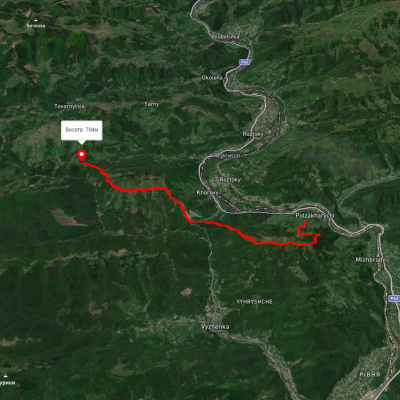
пер. Німчич - Протяте Каміння
